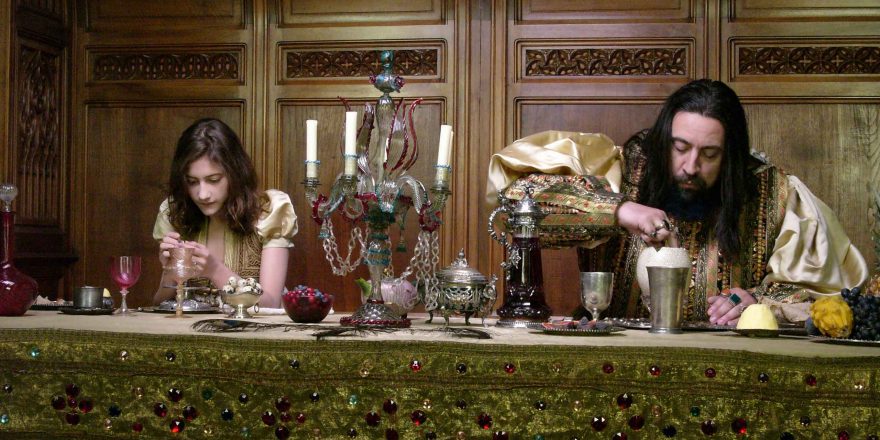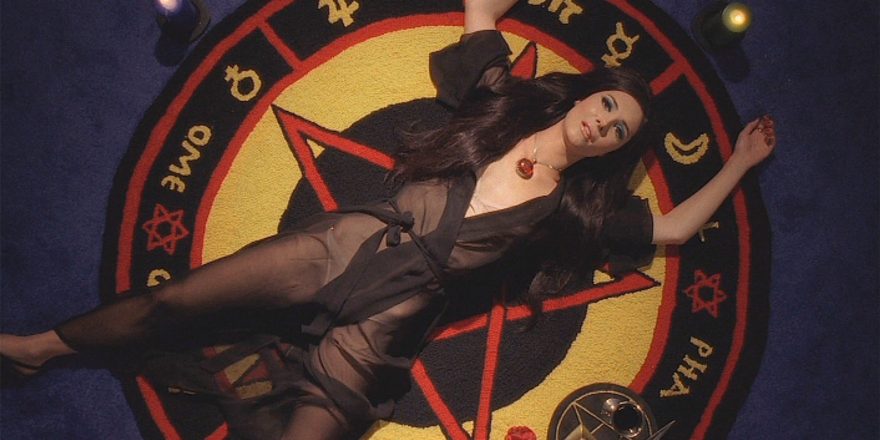I first started reading feminist theory years ago while I was a film student at CalArts, and I was lucky enough there to also have powerful feminist theorists (Berenice Reynaud) and practitioners (Nina Menkes) as guides and teachers. Nina’s work was a big inspiration for me at that time. It seemed to be utterly personal and intimate and to challenge male-oriented modes of filmmaking, but it was also pure, lush, beautiful, visual, visceral cinema. Particularly inspiring for me was seeing a 35 mm print of Queen of Diamonds (which has been restored by the Academy Film Archive and the Film Foundation and re-released by Arbelos Films), an utterly unique movie that has to be seen to be believed. Nina and I have kept in touch through the years, and she screened my film The Love Witch at the Bijou Theatre at CalArts a couple of years ago for her students. Although we may seem to be polar opposites as filmmakers, we do share a lot in common as female filmmakers trying to carve our own individualistic paths within a very male-dominated industry. Also, we are both trying to get at the root of lived female experience, which is something that’s rarer than it should be in cinema. It’s a pleasure to get to speak to Nina today about her filmmaking practice. Hi, Nina!
Nina Menkes: I’m getting ready to fly to New York for the premiere of Queen of Diamonds and feel extremely nervous! Even though I’ve shown the film many times over many years, I never feel calm about screening my work. Maybe because all my work is so personal. Do you feel afraid before screenings?
Anna Biller: I wouldn’t say I feel afraid, but I do get a lot of adrenaline flowing because I know I’m going to be interacting with people. My work is personal too, but audiences usually don’t ask me the really invasive questions so it’s more like stage butterflies. I get excited because I realize at screenings this is what I make the work for – to get feedback, to change people’s consciousness or make them curious. But then my work is so veiled, and I think yours is more raw. We both make personal films. That’s part of what I responded to so much in your film Queen of Diamonds. I tend to layer my personal experiences with clichés and stereotypes from the history of popular film so that one can sense the differences between what I am doing and what films usually do, in hopes that the audience picks up on the differences. It’s like a dog whistle for people who are attuned to the special experiences of women.
But you use an entirely different technique, which is to try to create a new film language, which completely fascinates me. So in Queen of Diamonds, we’re watching this woman at her croupier job, and the repetitiveness of it is anything but boring because we feel every inch of her experience. It’s an absolutely hypnotic experience watching it, the combination of the story, the acting, the synergy between you and your sister who plays the main role, and the craftsmanship. The editing is really important, all of the cinematic techniques. I’m wondering which cinematic techniques you consciously used to create the film’s special tone, or more specifically to create a new kind of film language?
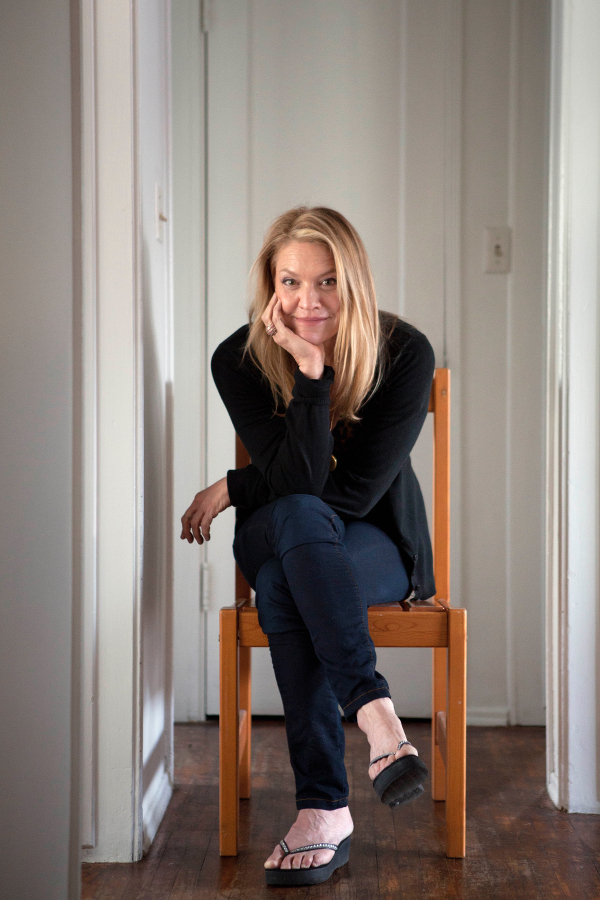
Menkes: I think my primary strategy is to tune in, deeply, to my inner experience of what’s happening in front of me in a scene, what’s really transpiring on a deep level. If I have a special talent in this sense, it’s probably in my connection, through the camera lens, to accessing a sort of X-ray of the scene. In looking through the lens, I feel a sense of truth; If I’m standing to the side of the camera, I don’t have access to that.
I tend to shoot fast because I’m trying to stay ahead of my conscious mind. I consider my intuition far smarter and more accurate than other parts of my mind. I need to avoid the part of my mind or self that’s intellectual or referential, and always try to stay very close to an inner voice, which is, in my experience, quite autonomous.
I’m really afraid that if I plan ahead I will find myself in a zone of re-creating, versus straight-up creating and discovering. While planning is an obstacle for me, preparing on an emotional level is something I take very seriously. I want to be fully and utterly emotionally prepared for a film, feeling deep into the roots of what is about to transpire, and then I sort of take a leap into the unknown, which I access via the lens.
Our editing process had a similar component, although here I was greatly assisted by the insights of my sister Tinka, who has a radical mind when it comes to cutting.
Biller: It’s really interesting to hear about how you work. I am the polar opposite. I have everything planned, scripted and storyboarded ahead of time, with hundreds of lists of props etc., because I don’t feel I can rely on my intuition in the moment. But I can definitely relate to that feeling of trying to be like a spirit medium on the set. You sort of go into a trance, and direct on autopilot. But I plan everything ahead because I never know if that magical intuition is going to kick in – and sometimes it doesn’t – so it’s a good back-up plan. But, of course, I don’t do my own cinematography so having storyboards is a way to make sure you get the shots that came from your mind at least at some point, so the DP doesn’t totally take over, which happened on my early sets.
Moving on to editing, I’ve always loved long takes, and scenes that allow themselves to play out in real time. Akerman’s Jeanne Dielman comes to mind, and that’s another strongly feminist movie. On my first rough cut, I always try to leave that kind of space. I love, for instance, watching a woman get dressed or cook or take a bath in real time. Those are always my favorite scenes, but then when I show them, people are always bored to death with those real-time scenes. My ritual scenes in The Love Witch were originally really long. I cut them to the bone and people sometimes still find that they drag. But I think that’s because you have to establish a rhythm and then stick with it. You can’t have fast scenes and slow scenes, or people won’t accept the slow scenes. But Queen of Diamonds has those real-time scenes in spades (pun intended). Do you want to talk about the editing decision to leave space for scenes to play out, and what that means specifically for creating a feminine/feminist space?
Menkes: While editing is also intuitive, I feel I bring more intellectual aspects into play, a more critical perspective. Tinka is the one who had many of the key radical ideas for cutting our films. Her genius is the ability to see straight into the essence of the situation, and then, with absolutely no compromise, to envision how the shape of the film needs to be, to self-express. I think of the name of Tarkovsky’s book Sculpting in Time … Tinka always managed to bypass any known laws of editing and just zero in on the essential quality of the experience. So in Queen of Diamonds, instead of five or six shorter casino/dealing scenes interspersed throughout, she understood the power of making one monster dealing scene.
I’m not sure I would name these spaces we created necessarily feminine or feminist spaces, even though, yes, they are surely that. But not primarily. My sense is that by tuning into a real felt experience and allowing that to be expressed, via shooting or editing, you end up with a very individual form. And an individual woman’s expression is going to run counter to master patriarchal constructions — which are pre-formed and fossilized. So yes, feminist, but not purposely so, just a precise self-expression.
My talk “Sex and Power; The Visual Language of Oppression” gets into some of those fossilized and oppressive standard ways of shooting and editing. In your work, you successfully play with those tropes and use them to question and twist away from their established meaning. For me, I can’t even go near that kind of shot design, it scares me!
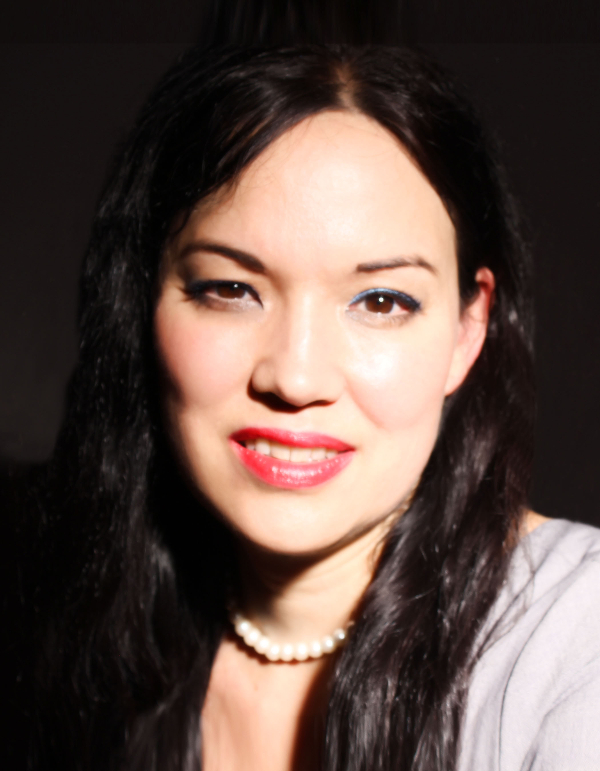
Biller: That’s very interesting. Also the fact that Tinka was both the actress and the one with the idea to do that casino scene in that super long take is fascinating, because of course that’s the way she experienced it, so that makes perfect sense. The idea of highlighting the worker’s experience that way is textbook Marxist-feminist, and you must have been aware of that. Not to keep bringing in other films, but it reminded me of Il Posto. I think the word “feminism” has been overused to the point of being ridiculous and often doesn’t apply, but there is something to be said for showing the experiences of women from the inside where it becomes instantly political for me – not in a cold or distanced way but in a bracing, refreshing way, where I suddenly feel that here is a movie that I can feel deeply from a different place than usual. Yes, it’s primarily an individual experience. And it shouldn’t seem so radical that the individual is a female, but it does. And that’s crazy, and makes us think about the lack of authentic female human beings in representation. And that’s feminist, because it changes consciousness. I first became aware of feminist theory in college and it changed my whole life, because it suddenly made the world make sense to me. What a lot of men don’t realize is that for women, feminism is a way of understanding your life and how it’s been shaped by outside forces.
For me, filmmaking is also about getting at the root of experience and trying to realize that as authentically as possible. But I do that through classical forms. As a film student, I first had the epiphany that using classical forms was a way for me to work through how much I’d been shaped by the movies I loved, what I wanted to keep and what I wanted to discard. I suppose that can read as kitsch when I admit to being enamored with non-serious things like glamour and interior decorating, but for me it’s a personal statement. There’s this whole debate thing about visual pleasure in cinema, how it’s been constructed by men, for men. But of course that doesn’t have to be true. Bret Easton Ellis once said in an interview that women aren’t visual. That’s how little women’s imagery has been in the public consciousness, that someone would seriously say something like that. So it’s really important, and yes really political for women to create images from their own place of authenticity.
Menkes: That’s such a great insight, that Tinka’s understanding of how to cut the casino scene came, at least in part, because she played the role and felt it, on her skin, in her hands, in her bones – and knew what it meant to stand there dealing cards for hours, in a way I could never know. In fact, the reason Tinka’s performances are so strong, is also that she doesn’t just feel the character and play the character but actually transforms completely into the character on a soul level. She isn’t exactly acting. It’s a different process than that of many other performers.
Regarding feminism, I think what’s key for me is what you said about the radical nature of showing the female experience. This is the main point of my lecture on classical/traditional male dominated cinema — as has been pointed out by Laura Mulvey et al., women are generally relegated to the object position, they are not individuals with complex, detailed historical, political and emotional experience, but are primarily seen as existing for the gratification of others, who are men, and their/our physical attributes are the key qualities of interest. So just the fact of having a complex woman as an individual on screen with an inner life is already radical. Seems absurd, but that is, indeed, the case. My “Sex and Power” lecture, just shows how, over many decades, a good majority of A-list directors (men and women), treat their lead female characters photographically in a way that relegates them to this eternal object position. When you see it again and again over decades from all the cinema “greats,” it’s pretty shocking. This is a form of violence against women, masquerading as sexy glamour. In your films, you successfully take that glamour and make a decision to own it, to claim it, to incorporate it into your character’s sense of self. This is a tricky path to navigate, and for myself, I have to avoid entirely the kind of shots which travel over a young woman’s body, naked or semi naked, and all the rest.
When we say “visual pleasure,” we have to ask, visual pleasure for whom? Right? For me, Jeanne Dielman, or Tinka Menkes on screen is pure visual pleasure!
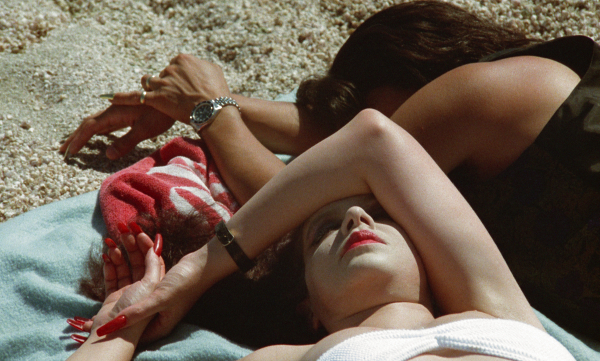
Biller: That’s exactly the question for me: “Visual pleasure for whom?” I think we need a much more sophisticated discussion around movies, where we talk about which movies perform violence against women and which ones don’t or are more nuanced. And I think we need to talk about the shift in movies from before and after the sexual revolution, because there was a radical shift in the way women in movies were viewed.
You say you try to be authentic in the moment when you’re shooting a film, and for me I try to be authentic about how I view myself and other women, even if that’s not politically correct. It’s a fetishistic, scopophilic glance for sure. But the fetish for me (and I’ve noticed this is the same for other women) is often in the clothing and makeup one uses as a shield against the world or as a sort of playfulness or masquerade. So, for instance, in The Love Witch it’s all about the Victorian dresses which are long-sleeved and high-necked, and about the layers of makeup and wig which constitute a mask, the polar opposite of how witches were filmed in the ’60s and ’70s, which was as nude as possible. And then it’s all about her inner world, and everything is seen from her point of view, where the men become projections of her inner psyche and not really fleshed out in themselves, which is how we usually see women in films.
I don’t have a problem with men having expressed themselves so much in every medium and having nearly exhausted all the possibilities of expression and projection onto women and all the rest. What bothers me is that most people think that’s all there is, and accept so readily the idea that women are just less important and interesting and that’s why we don’t get more nuanced female characters. And then when they see another point of view, it feels “wrong” to them because it’s not what they’re used to (and is even threatening to many men). And the most outwardly woke people adore the most misogynistic movies – sometimes as irony, but they still love them – which is happening more and more, and I think is partly due to the fact that people are ignorant of the other possibilities for film, including classic movies which featured a lot of interesting female characters.
Before we finish, I’d love to hear your thoughts on why you made Queen of Diamonds and what you were trying to express about that character and her world.
Menkes: Queen of Diamonds came to me, like all my films, in a sort of flash – I “received” it. A film about a blackjack dealer in Vegas: a drifter, a loner, a woman who earns minimum wage and oils the machine for others’ profits. … In my mind (having never been to Vegas), I imagined this high-class, elegant but cold woman, like the old casinos of Europe, in a velvet dress, that type of thing. When I actually went to Vegas to scout locations, at first I was turned off by how cheap and fake and kitschy it all was!! But then I realized that this aspect of Americana was so perfect for my character … who, by the way, also wears a sort of mask, her white-ish makeup, and her very long, almost surreal nails (real dealers all have very short nails).
I started to reimagine the film based on things I had seen on my location scouting, like elephants walking the streets, or learning about palm trees that independently and without reason ignite in the middle of the desert! I saw my main character as someone who — and I guess this can be said for all my characters — is in total resistance to the patriarchal system she supports through her labor … but sees no way out. Her interior refusal is itself her answer, though it leaves her, in a way, in a profoundly untenable position.
I read a beautiful essay about Anne Sexton once, where the author wondered if Sexton’s suicide perhaps came, in some part, from her inability to name and connect with her own Gods. I think that is key for all us, and especially for artists who experience themselves in resistance, one way or another, to The Canon! But it is not an easy thing to do.
Biller: Thank you for speaking with me, Nina. It’s fascinating to hear about your process, which we’ve never spoken about. I love the idea that we can both speak to female experience from such opposite working methods. To finish, could you talk about what was polarizing for audiences when you first screened Queen of Diamonds?
Menkes: Sarah Resnick just published a really beautiful piece about this film in 4Columns, in which she references a screening, many years ago, at the AFI Film Festival in Washington D.C., in which a number of men loudly booed the movie!! I had forgotten about that, but over the years, yes, my work has definitely always split audiences. Queen of Diamonds originally premiered in the Dramatic Competition at Sundance 1991. Gus Van Sant was a juror at Sundance that year and told me I almost won the Grand Prize! At the same time, many people walked out of the screenings. The film is not “entertaining” and it pushes you back upon yourself, which is something many people dislike. In addition, there is a strong resistance to the kind of feminine cinematic figure Tinka represents. She is not friendly and fuckable, shall we say. And some people feel very hostile towards her!
At the same time, many others feel a sense of gratitude and relief that this woman exists on screen and radiates a certain secret power. This is the power of a woman who hasn’t swallowed the sexist Kool-Aid. But it’s important to remember, she pays a high price for that. Actually, you pay a high price either way – swallowing or not swallowing! – right? Obviously, I chose to walk the path of making movies in my own way, in my own language, and damn the consequences. This new restoration, and the great reception we are getting 27 years after the film was first created, is a profoundly beautiful experience for me.




